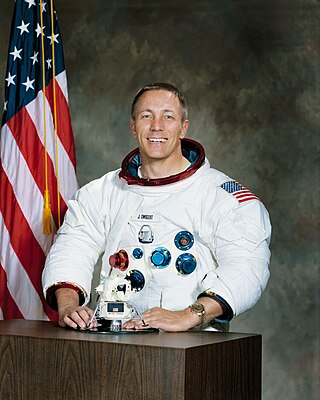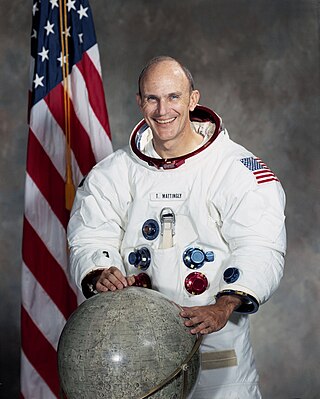
William Alison Anders is an American former United States Air Force (USAF) major general, former electrical engineer, nuclear engineer, NASA astronaut, and businessman. In December 1968, he was a member of the crew of Apollo 8, the first three people to leave low Earth orbit and travel to the Moon. Along with fellow astronauts Frank Borman and Jim Lovell, Anders circled the Moon ten times, and broadcast live images and commentary back to Earth. During one of the mission's lunar orbits, he took the iconic Earthrise photograph.

Edgar Dean Mitchell was a United States Navy officer and aviator, test pilot, aeronautical engineer, ufologist, and NASA astronaut. As the Lunar Module Pilot of Apollo 14 in 1971 he spent nine hours working on the lunar surface in the Fra Mauro Highlands region, and was the sixth person to walk on the Moon.

Russell Louis "Rusty" Schweickart is an American aeronautical engineer, and a former NASA astronaut, research scientist, U.S. Air Force fighter pilot, as well as a former business executive and government executive.

John Leonard Swigert Jr. was an American NASA astronaut, test pilot, mechanical engineer, aerospace engineer, United States Air Force pilot, and politician. In April 1970, as command module pilot of Apollo 13, he became one of 24 astronauts who flew to the Moon. Ironically, due to the "slingshot" route around the Moon they chose to safely return to Earth, the Apollo 13 astronauts flew further away from Earth than any other astronauts before or since, though they had to abort the Moon landing.

Charles Stark "Doc" Draper was an American scientist and engineer, known as the "father of inertial navigation". He was the founder and director of the Massachusetts Institute of Technology's Instrumentation Laboratory, later renamed the Charles Stark Draper Laboratory, which made the Apollo Moon landings possible through the Apollo Guidance Computer it designed for NASA.

The Columbia Accident Investigation Board (CAIB) was an internal commission convened by NASA to investigate the destruction of the Space Shuttle Columbia during STS-107 upon atmospheric re-entry on February 1, 2003. The panel determined that the accident was caused by foam insulation breaking off from the external fuel tank, forming debris which damaged the orbiter's wing, and that the problem of "debris shedding" was well known but considered "acceptable" by management. The panel also recommended changes that should be made to increase the safety of future shuttle flights. The CAIB released its final report on August 26, 2003.

Frederick Hamilton "Rick" Hauck is a retired captain in the United States Navy, a former fighter pilot and NASA astronaut. He piloted Space Shuttle mission STS-7 and commanded STS-51-A and STS-26.

Norman Earl Thagard, is an American scientist and former U.S. Marine Corps officer and naval aviator and NASA astronaut. He is the first American to ride to space on board a Russian vehicle, and can be considered the first American cosmonaut. He did this on March 14, 1995, in the Soyuz TM-21 spacecraft for the Russian Mir-18 mission.

John McCreary Fabian is a former NASA astronaut and Air Force officer who flew two Space Shuttle missions and worked on the development of the Shuttle's robotic arm. He later led the Air Force's space operations.

Jeffrey Alan Hoffman is an American former NASA astronaut and currently a professor of aeronautics and astronautics at MIT.

Thomas Kenneth Mattingly II was an American aviator, aeronautical engineer, test pilot, rear admiral in the United States Navy, and astronaut who flew on Apollo 16 and Space Shuttle STS-4 and STS-51-C missions.

Ronnie Walter Cunningham was an American astronaut, fighter pilot, physicist, entrepreneur, venture capitalist, and author of the 1977 book The All-American Boys. NASA's third civilian astronaut, he was a lunar module pilot on the Apollo 7 mission in 1968.

Norman Ralph "Norm" Augustine is a U.S. aerospace businessman who served as United States Under Secretary of the Army from 1975 to 1977. Augustine served as chairman and CEO of the Lockheed Martin Corporation. He was chairman of the Review of United States Human Space Flight Plans Committee.
Peter Edward Glaser was a Czechoslovakian-born American scientist and aerospace engineer. He served as Vice President, Advanced Technology (1985–94), was employed at Arthur D. Little, Inc., Cambridge, MA (1955–94); subsequently he served as a consultant to the company (1994–2005). He was president of Power from Space Consultants (1994–2005). Glaser retired in 2005.
The Eugene M. Emme Award is an award given annually to a person or persons selected by a panel of reviewers from the American Astronautical Society History Committee to recognize "the truly outstanding book published each year serving public understanding about the positive impact of astronautics upon society." The award is in honor of Eugene M. Emme, NASA's first historian.

The National Space Council is a body within the Executive Office of the President of the United States created in 1989 during the George H. W. Bush administration, disbanded in 1993, and reestablished in June 2017 by the Donald Trump administration. It is a modified version of the earlier National Aeronautics and Space Council (1958–1973).

"We choose to go to the Moon", formally the Address at Rice University on the Nation's Space Effort, is a September 12, 1962, speech by United States President John F. Kennedy to bolster public support for his proposal to land a man on the Moon before 1970 and bring him safely back to Earth. Kennedy gave the speech, largely written by presidential advisor and speechwriter Ted Sorensen, to a large crowd at Rice University Stadium in Houston, Texas. In his speech, Kennedy characterized space as a new frontier, invoking the pioneer spirit that dominated American folklore. He infused the speech with a sense of urgency and destiny, and emphasized the freedom enjoyed by Americans to choose their destiny rather than have it chosen for them. Although he called for competition with the Soviet Union, Kennedy also proposed making the Moon landing a joint project. The speech resonated widely and is still remembered, although at the time there was disquiet about the cost and value of the Moon-landing effort. Kennedy's goal was realized posthumously, in July 1969, with the Apollo program's successful Apollo 11 mission.
Richard "Dick" Horace Battin was an American engineer, applied mathematician and educator who led the design of the Apollo guidance computer during the Apollo missions during the 1960s.

Roger D. Launius is an American historian and author of Lithuanian descent, a former chief historian of NASA. He retired in 2016 as Associate Director for Collections and Curatorial Affairs for the Smithsonian National Air and Space Museum in Washington, D.C. Launius is a consulting historian in air and space history. He has written many books on space flight, and also published on the history of the Latter Day Saint movement.

Mike Gruntman is a physicist, space engineer, and author. He is professor of astronautics and aerospace engineering at the Viterbi School of Engineering, University of Southern California (USC).

















